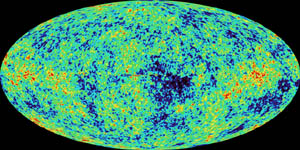Cosmology - The Study of the Universe
By the University of Chicago
 * Kicp.uchicago. * Sciencechicago.com * Events
* Kicp.uchicago. * Sciencechicago.com * EventsCosmology is the study of the Universe as a whole and its history since the beginning. Here you will find our on-going research to study cosmological phenomena, such as the inflation of the universe, the growth of structures, and the cosmic microwave background radiations. (more)
* Related Research Projects by Universities and Astrophysic Agencies:
• COSMUS
• ESA's Planck Mission
• Extragalactic Astronomy
• MSAM-TopHAT Experiment
• Dark Energy Survey (DES)
• Microwave Anisotropy Probe (MAP)
• Degree Angular Scale Interferometer (DASI)
• Stratospheric Observatory For Infrared Astronomy (SOFIA)
• High Energy Astrophysics
• Sloan Digital Sky Survey (SDSS)
• South Pole Telescope (SPT)
• Sunyaev-Zeldovich Array (SZA)
• Joint Institute for Nuclear Astrophysics (JINA)
• Interferometric Sunyaev-Zel'dovich Effect Imaging Experiment (SZE)
• Very Energetic Radiation Imaging Telescope Array System (VERITAS)
• Center for Magnetic Self Organization in Astrophysical and Laboratory Plasmas (CMSO)

Understanding the Cosmos is undergoing a revolution with fields as diverse as high energy physics and astronomy converging in theory and experiments.
• P. A. Observatory: A Century-Old Mystery Unveiled: The Most Energetic Particles to Reach Earth Come From Outside the Milky Way (more)
- Cosmic rays are energetic subatomic particles from space that can have energies 10 million times greater than those created by man-made particle accelerators. Their origin has been a mystery for almost a century, ever since their discovery in 1912. The Pierre Auger Observatory in Argentina, an international effort involving 17 countries and hundreds of scientists, including an active group at KICP led by Auger Spokesperson Emeritus James Cronin and University of Chicago faculty members Angela Olinto and Paolo Privitera, has recently measured the arrival directions of the highest energy cosmic rays. The pattern in the sky created by these particles reveals that the most energetic particles do not come from every direction in space.

- The arrival directions of the 27 highest energy cosmic rays detected by Auger projected onto the celestial sphere of our Universe (black circles of radius 3.1o). The positions of 472 AGN within 75 Megaparsecs are shown as red stars.
The highest energy particles are very rare: over an area of one square kilometer, only one particle per century reaches the Earth. To meet this challenge, the Pierre Auger Observatory covered an area of 3000 km2 and completed its construction in early 2008. Since it began operation in January 2004, the Auger Observatory has collected 27 particles with energies above 5.7 x 1019 eV. These particles are the first to show a positive correlation between nearby active galaxies (AGNs) and the highest energy cosmic rays. Their arrival directions correlate well with the distribution of active galaxies located less than 180 million light years (or 1.7 x 1021 km) from Earth. These findings are summarized in recent publications by the Pierre Auger Collaboration in Science and Astroparticle Physics. MORE »

- Pierre Auger Observatory surface detector for cosmic energetic particles with the Andes in the background.
• Science Magazine: Correlation of the Highest-Energy Cosmic Rays with Nearby Extragalactic Objects
• Kavli Institute: Correlation of the highest-energy cosmic rays with the positions of nearby active galactic nuclei (Pdf)

 • TIME:
• TIME: 

 •
•  •
•  •
•  •
•  • ABC:
• ABC:  •
•  •
•  •
• 
 •
•  •
• 






